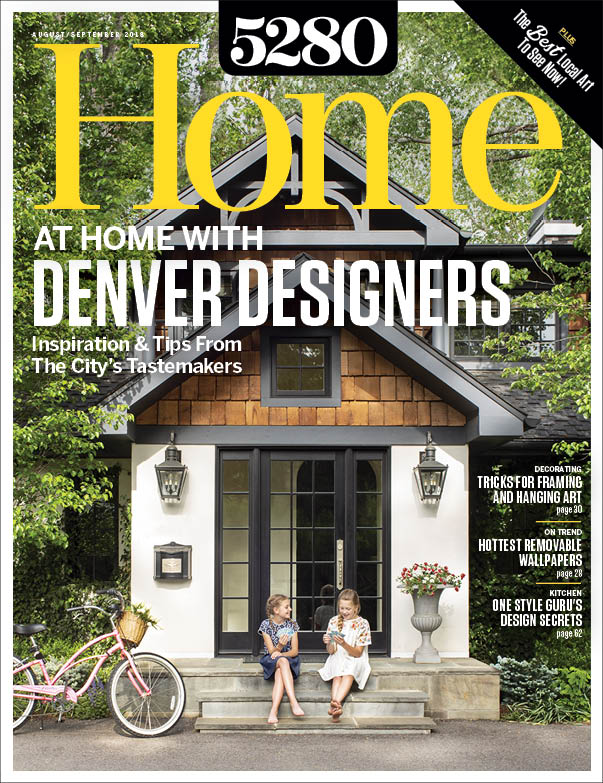The Local newsletter is your free, daily guide to life in Colorado. For locals, by locals.
You’d expect a professional interior designer who is married to an architect to have a Pinterest-worthy abode. But throw kids into the mix and even the most nonplussed design legend can find her house littered with toys and Technicolor playthings. Not so for designer Devon Tobin, who spends her days at the helm of Littleton’s Duet Design Group, which she co-founded, and every other minute with her husband, Caleb, and two sons back at their 1,700-square-foot Virginia Village home. Built in 1956, the three-bedroom, two-bathroom split level is a curated mix of objets that hold personal meaning for Tobin and her family, with nary a design trope in sight. Here, Tobin shares some of her favorite decorating lessons.

5280 Home: Your house is so fun! How did you approach the design?
Devon Tobin: This place was disgusting when we first saw it, but what it had was a good layout. If you have a bad one, you’re going to spend tons of time and money trying to get it to flow correctly. The prior owner attempted to turn what should have been a more modern home into a very traditional one, so we undid that in a lot of places—I wanted to bring it back to what it was meant to be. For example, the kitchen had very, very heavy wood panel doors with a country backsplash and Formica countertops, and everything was just cheapened. You can’t do that to a home! You can’t make a home’s bones different; it feels off.

So you ripped out all the faux, traditional “charm”?
Yes, in terms of tile, flooring, and windows, you need to stay true to the integrity of the home. Most of what we did was aesthetic: painting the pinkish walls white, changing light fixtures, adding new furniture and artwork. Even in the bathrooms, we remodeled; we used IKEA vanities. Luckily, nothing was crazy-expensive because we didn’t have to move any walls. Our house was all about enhancing finishes and making it timeless. In terms of furniture, I’m eclectic—modern yet traditional. I’m somewhat drawn to cleaner lines, but I own a ton of my grandma’s old pieces and make them work. I appreciate their stories.

Is timelessness one of your design principles?
It’s a rule: Unless you’re building a custom home for yourself and you’re going to live in it for 20 years, be careful that you’re adding a return on your investment and not just following your whims—or someone else’s.
What are your other decorating rules?
Don’t say you only like one style, because you’ll limit yourself. I’ll meet with a client and she’ll say, “I think I’m really traditional.” I listen [to her ideas and preferences] and then say, “You’re actually transitional and lean a little modern.” And she’s like, “Really?” I love to help clients discover what they like. And when someone says to me, “This is from my mom; she passed away,” we always find a spot for it.

Love that. Tell us, what are your other gripes?
As I get older, I don’t like rooms that lack a function. If you live in a 12,000-square-foot house, you’ll probably have rooms you don’t use. Every room should support functional habits or ways of living, and if one doesn’t, the room is wrong. When you have an efficient home, you don’t have to skimp on quality. You can make it perfect.

Pier 1 supply warm texture. The mismatched bed and nightstands are from West Elm. Photograph by David Lauer
Your home is so personal; it’s not a page from a catalogue. And you really live in it.
I got the dining room furniture at an old thrift store in Highland called Red Door, and they’re all real 1960s pieces. What I love about them is that at this point, they’re beat up, so I can tell my artistically inclined son, “You know what, buddy? You can get paint on the table; it’s fine.” If I inhibit creativity, it becomes a fragile house, and I don’t ever want that. Our house is always clean, organized, warm, and comfortable, but it’s also a home.

That’s exactly it.
People underestimate how important their homes are for their memories. Space and design affects the way we live and function so much more than people understand. There’s an old chair my husband had in storage that belonged to his grandmother; she wanted him to have it. We reupholstered it in old-looking Schumacher fabric, and now it sits in our son’s room. Maybe one of our boys will take it someday. We’re creating a fondness for things from the past; pieces with stories are what give a house a homey feel. Everything doesn’t look new; it looks like someone actually lives here.

Design Pro
Interior design: Devon Tobin, Duet Design Group









